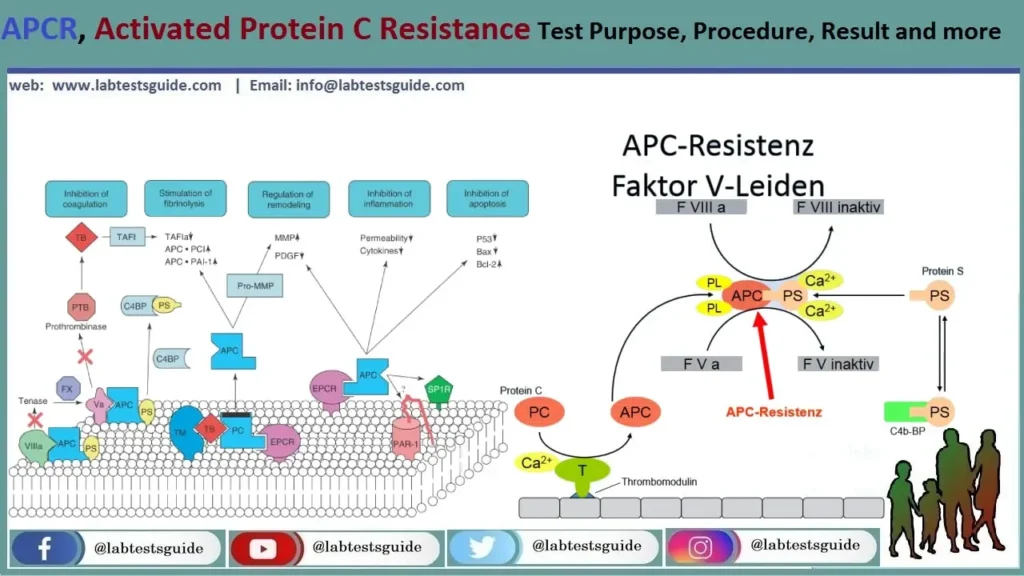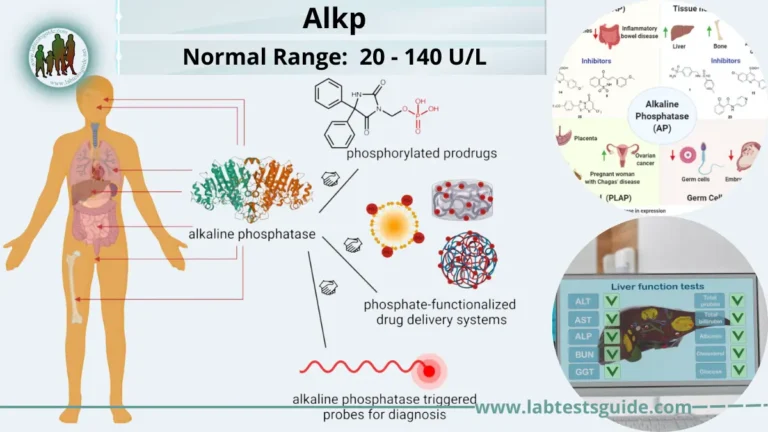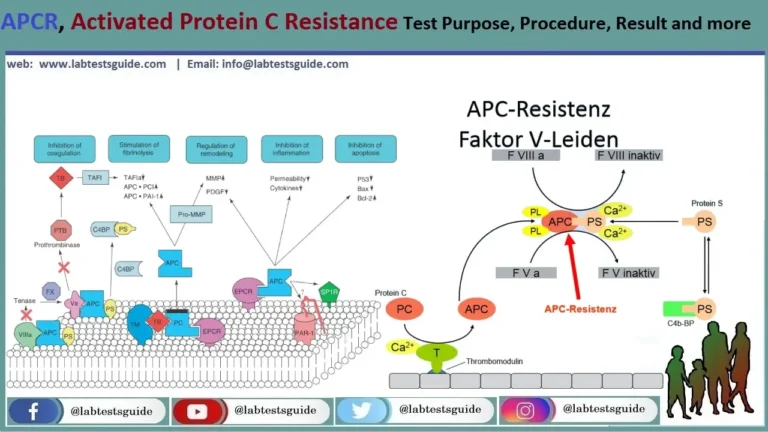APC resistance, also known as activated protein C resistance, refers to a condition in which there is reduced sensitivity of the clotting system to the anticoagulant effects of activated protein C. It is primarily associated with a specific genetic mutation known as Factor V Leiden.

| Also Known as | Protein C, Activated Protein C, APC, Protein S, Activated Protein S, APS, Activated Protein C Resistance, Activated Protein C Resistance V, APCRV, Protein C Activity, Protein C Level, Protein S Activity, Protein S Level, APC Resistance, APCR, |
| Test Purpose | Evaluation of patients with incident or recurrent venous thromboembolism |
| Test Preparations | Patient Discontinues Heparin For 1 Day And Oral Anticoagulants For 7 Days Prior To Sampling |
| Test Components | Activated Protein C Resistance |
| Specimen | 3 ML Whole Blood In 1 Blue Top (Sodium Citrate) Tube. |
| Stability Room | 4 Hours |
| Stability Refrigerated | 4 Hours |
| Stability Frozen | 2 weeks |
| Method | Electromechanical Clot Detection |
| Download Report | Download Report |
Activated protein C resistance (APCR) is hypercoagulability (an increased tendency for blood to clot) characterized by a lack of response to activated protein C (APC), which normally helps prevent blood from clotting excessively . This results in an increased risk of venous thrombosis (blood clots in the veins), resulting in medical conditions such as deep vein thrombosis (usually in the leg) and pulmonary embolism (in the lung, which can cause death).The most common cause of hereditary resistance to APC is the factor V Leiden mutation.
The diagnosis of APC resistance is typically confirmed through laboratory testing, such as the APC resistance assay or the functional coagulation assay. These tests involve measuring the response of the patient’s blood clotting system to activated protein C.
Types:
Protein C
There are two types of inherited protein C deficiencies:
- Type 1 is related to an insufficient amount.
- Type 2 is associated with abnormal function and is less common than type 1.
Protein S
There are three types of inherited protein S deficiencies:
- Type 1 deficiency is due to not enough.
- Type 2 is due to abnormal function.
- Type 3 is due to decreased free protein S levels, although total protein S levels are normal.
Why get tested?
To help investigate the cause of a blood clot (thromboembolism), such as deep vein thrombosis (DVT) or pulmonary embolism (PE)
to determine if you may have a protein C or protein S deficiency
When to get tested?
Protein C and protein S tests may be ordered when:
- You have had a blood clot, especially when you are relatively young (younger than 50 years old)
- You have had a clot in an unusual location, such as the veins coming from the liver or kidney or the blood vessels of the brain
- You have had multiple clotting episodes
- You do not have any other obvious reasons for developing a blood clot
Sample Required:
3 ML Whole Blood In 1 Blue Top (Sodium Citrate) Tube. Mix Thoroughly By Inversion.
Test Preparation Needed:
It Is Recommended That Patient Discontinues Heparin For 1 Day And Oral Anticoagulants For 7 Days Prior To Sampling As These Drugs May Affect Test Results. Discontinuation Should Be With Prior Consent From The Treating Physician.
Normal values:
APTT-based method. Guide only, check with laboratory.
- Normal: > 2.2
- Equivocal: 2.0-2.2
- Abnormal: < 2.0
RWT-based method. Guide only; check with laboratory.
- Normal: > 1.8
- Equivocal: 1.6-1.7
- Abnormal: < 1.6
Interpretations:
Resistance to activated protein C is associated with an increased risk of venous thromboembolism.
However, as the condition is detectable in ~5% of all individuals, an abnormal APCR result does not necessarily indicate a predisposition to future thrombosis.
The disorder is characterized by a low plasma anticoagulant response to the addition of activated protein C.
The abnormality has been reported in 20-60% of patients with venous thromboembolism, although thrombosis usually only occurs when additional risk factors are present.
A single gene mutation (factor V Leiden) has been described in >90% of APC-resistant patients and can be detected by DNA testing.
Acquired APC resistance can occur during pregnancy and in the presence of inflammation.
| TYPE OF DEFICIENCY | FREE PROTEIN S | TOTAL PROTEIN S ANTIGEN | TOTAL PROTEIN S ACTIVITY |
|---|---|---|---|
| 1 | Decreased | Decreased | Decreased |
| 2 | Normal | Normal | Decreased |
| 3 | Decreased | Normal | Decreased |
Q: What does APCR stand for?
A: APCR stands for “Activated Protein C Resistance”.
Q: How to abbreviate “Activated Protein C Resistance”?
A: “Activated Protein C Resistance” can be abbreviated as APCR.
Q: What is the meaning of APCR abbreviation?
A: The meaning of APCR abbreviation is “Activated Protein C Resistance”.
Q: What is APCR abbreviation?
A: One of the definitions of APCR is “Activated Protein C Resistance”.
Q: What does APCR mean?
A: APCR as abbreviation means “Activated Protein C Resistance”.
Q: What is shorthand of Activated Protein C Resistance?
A: The most common shorthand of “Activated Protein C Resistance” is APCR.
APCsr – Activated Protein C Sensitivity Ratio
APC-R – Activated Protein C Resistance Condition
JNK/SAPK – c-Jun NH2-Terminal Kinase/Stress-Activated Protein Kinase
JNK1/SAPK – c-Jun N-Terminal Kinase 1/Stress-Activated Protein Kinase
PROWESS – Recombinant Human Activated Protein C Worldwide Evaluation in Severe Sepsis
R-APC – Resistance to Activated Protein C
APC – Activated Protein C
HAPC – Human Activated Protein C
rhAPC – Recombinant Human Activated Protein C
APCR – Active Protein C Resistance
APC – activated human protein C
CePAK – C. elegans p21-activated protein kinase
HAPC – Human anticoagulant activated protein C
JNK MAPKs – c-Jun N-terminal protein kinase mitogen-activated protein kinases
JNK/SAPK – c-Jun NH(2)-terminal protein kinase-stress-activated protein kinase
JNK/SAPKs – c-Jun N-terminal kinase/stress-activated protein kinases
RAPC – recombinant human activated protein C
RAPC – resistance to activated protein C
APC-R – Activated protein C resistance
EPCR – endothelial cell protein C/activated protein C receptor
Possible References Used





